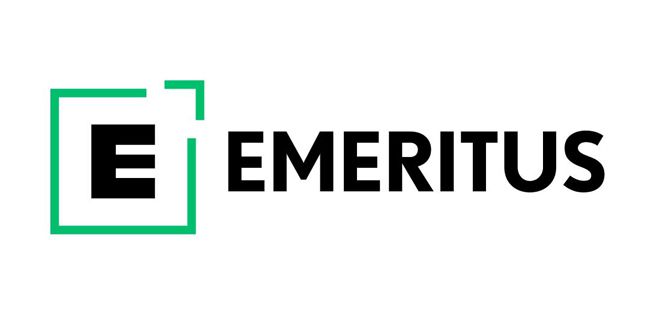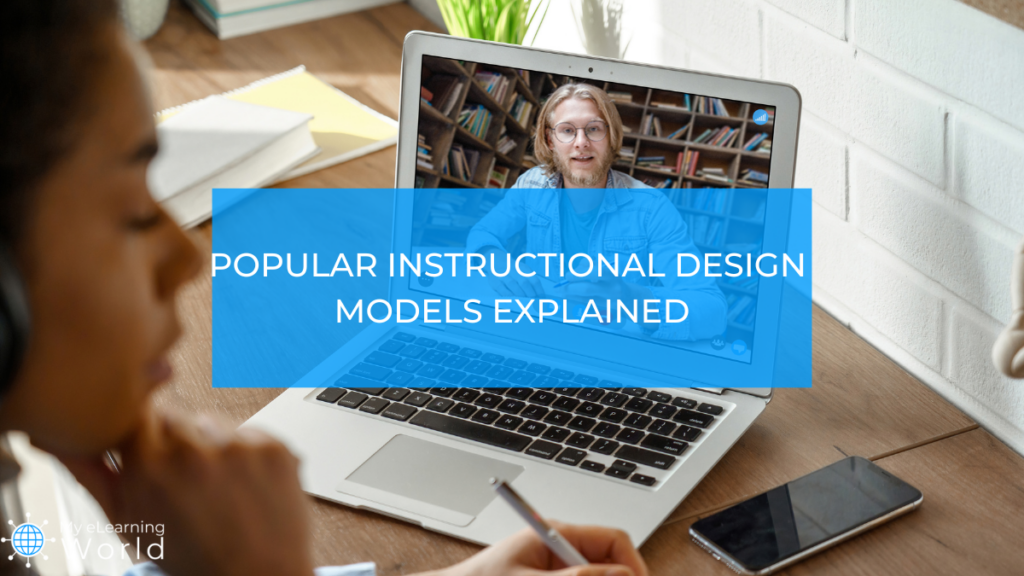Revolutionary changes in education and training have brought instructional design to the forefront in recent years. This formalized process is being adopted across industries, including higher education, corporate spheres, and government sectors. The aim is to quickly and effectively impart essential information and skills to individuals on a large scale.
By combining proven theories of learning with instructional design models, instructional designers can create engaging, effective learning experiences that promote retention and skill acquisition. Simply put, understanding instructional strategies can help you create an online course that’s highly effective.
In this post, I’ll define and analyze the key instructional design models being used today in training programs of all types, including ADDIE, Bloom’s Revised Taxonomy, Design Thinking Model, Merrill’s Principles of Instruction, and more. I’ll also discuss how you can master the most important instructional design models with the Professional Certificate in Instructional Design program from Emeritus.
 Emeritus Professional Instructional Design Certificate | Online Certificate Course
Emeritus Professional Instructional Design Certificate | Online Certificate Course
Gain firsthand expertise in instructional design principles and methodologies through this unique Professional Certificate program. Create impactful learning solutions and improve people's ability to learn.
The next class kicks off on October 22, 2024, so don't miss your chance to enroll now! Take advantage of early bird discounts leading up to the kickoff date:
20% off until September 3
15% off until September 24
10% off until October 15
What are the Major Instructional Design Models?
The major instructional design models are:
- ADDIE model (Analysis, Design, Development, Implementation, and Evaluation)
- Bloom’s Revised Taxonomy
- Design thinking model
- Merrill’s principles of instruction
- Gagne’s nine events of instruction
- ARCS (Attention, Relevance, Confidence, Satisfaction) model
I’ll go into detail about each of these instructional strategies and methodologies below…
1. ADDIE model
ADDIE model is used for developing e-learning courses. The acronym ADDIE represents five phases, namely: Analysis, Design, Develop, Implement, and Evaluate.
Phases
ADDIE is a cyclical model where the outputs from one phase feed into the next as inputs. This makes it flexible and ideal for feedback gathering. That’s why it’s one of the most popular types of instructional design methods.
1. Analyze
What is the purpose of the online course? To define the purpose, instructional designers (IDs) collect information about students (such as their learning needs) and the organizational expectations of the online course (content and context). Outputs include a task list and instructional objectives.
2. Design
The ID chooses an instructional strategy to guide e-course development. They also define the objectives, delivery system, test items, description of the target population, and instruction sequencing.
3. Develop
The online course is finalized and all the instructional materials are completed. It could be in hardware (such as simulation) or software format (electronic-based course). The ID generates lesson material and plans as well as any relevant documentation during the development process.
4. Implement
The ID delivers the learning program to the organization and rolls it out to the learners. The course could be rolled out in the classroom, lab, or via the computer on learning management systems. This phase aims to ensure that lesson instruction is efficient and effective.
5. Evaluate
The ID assesses whether the course and instructional materials meet the learners’ and organization’s needs and expectations. The assessment could be summative or formative.
- Summative evaluation occurs after the final rollout and informs the decision to purchase, continue, or discontinue the course.
- Formative evaluation determines if the online course can be improved before the final version is rolled out.
Each phase is collaborative, meaning that the ID collaborates with stakeholders to ensure they are satisfied before proceeding to the next one.
How it is used
The ADDIE model is mostly used in designing e-learning courses and instructional materials. It is one of the oldest models of instructional design.
The drawback with the ADDIE model is that some instructors have called its effectiveness into question.
However, you can pair it with other instructional design methodologies (such as the ARCS model or Gagne’s 9 events of instruction) for effective instruction and learning.
2. Bloom’s Taxonomy (Revised)
Bloom’s Taxonomy organizes learning objectives in a hierarchy. Within the hierarchy are 3 domains: cognitive, affective, and psychomotor.
The cognitive domain concerns experiences and thinking, while the affective domain concerns feelings and emotions. Lastly, the psychomotor domain concerns practical and motor skills.
Each domain has different learning levels, arranged from the simplest to the most complex.
Phases
Bloom’s Revised Taxonomy has three domains:
1. Cognitive
The cognitive learning domain has six categories or objectives.
| Category | Meaning |
| Remembering | Recalling learned information and existing knowledge |
| Understanding | Translating, interpolating, and interpreting problems and instructions |
| Applying | Using concepts from learned information and existing knowledge |
| Analyzing | Separating concepts into parts that can be understood |
| Evaluating | Judging the value of content or ideas |
| Creating | Building patterns or structures to create a new meaning |
2. Affective
The affective domain describes how people deal with their emotions, attitudes, and motives. It has 5 categories.
| Category | Meaning |
| Receiving | How aware and willing the learner is to hear or attend to stimuli |
| Responding | The learner’s active participation (reaction and compliance to stimuli) |
| Valuing | The worth attributed to behavior or a stimulus |
| Organizing | How learners compare, synthesize, and prioritize different values |
| Internalizing | How does the value system control learner’s behavior? |
3. Psychomotor (sensory)
The psychomotor domain is concerned with motor skills and coordination. Categories within this domain include:
| Category | Meaning |
| Perception | Using sensory cues in motor activity |
| Set | Response to a situation (mindsets) |
| Guided response | The early learning stage is characterized by trial and error |
| Mechanism | Intermediate learning stage where habits are formed and proficiency is achieved |
| Complex overt response | Skilled motor performance through accuracy, high coordination, and speed |
| Adaptation | Modifying movements to suit the environment |
| Origination | Developing new movements with creativity |
How it is used
Bloom’s Taxonomy is applicable in learning environments that promote advanced thinking such as analysis.
It is handy in the planning process, such as lesson planning. Instructors and IDs can use this model to draft classroom learning objectives for their lesson plans.
Here’s how to apply Bloom’s (Revised) Taxonomy in the classroom:
- Incorporate action verbs in the learning objectives
- Draft learning questions to inspire cognitive development, such as “how many” to provoke remembering.
- Include action-verb questions in class discussions to encourage deeper learning.
3. Design thinking model
This solution-based instructional design framework focuses on learner empathy. The ID takes on the role of an ethnographer to understand and empathize with the learner’s needs.
Becoming an ethnographer helps the ID develop creative learning solutions relevant and valuable to the learner.
Phases
1. Empathize
The ID observes learners and asks questions to gain insight into their needs and experiences. This empathetic stance pushes the IDs to set aside their biases and assumptions. This helps them focus on getting the users’ needs accurately.
2. Define
After gathering the users’ information, the ID analyzes and consolidates the information to define a problem statement.
3. Ideate
This is a creative phase where solutions are defined. Its purpose is to spark a range of solutions that the instructional designer can adopt in the next phase. Common ideation techniques are brainstorming, storyboarding, sketching, worst idea, and storyboarding.
This is an important phase because the ID shifts focus from empathy and problem definition to coming up with solutions.
4. Prototype
The instructional designer creates a scaled-down model that solves the learners’ problem. Its purpose is two-fold:
- To validate ideas from the previous stage and pick the best solution.
- To collaborate with users so that the end product solves their learning problem.
5. Test
The instructional designer tests the final product and collects the results. The findings inform the decision to re-examine the problem and the users’ needs. The outcome is a modification or remodeling of the learning system.
How it is used
You can use this model to develop courses or solutions where the problem is ill-defined. You can solve poor problem definitions in the empathetic stage.
4. Merrill’s principles of instruction
Merrill’s principles of instruction integrate five learning fundamentals that ensure learners get maximum knowledge from an online course. The five principles are task-centered, activation, demonstration, application, and integration.
David Merrill developed the instructional learning methodology in 2002 to help learners:
- Relate a task or problem to the real world.
- Connect prior learning/existing knowledge with new knowledge.
- Apply new knowledge independently through trial and error.
- Share this knowledge to promote memory retention and recall.
- Relate the knowledge with their world through discussions and reflection.
Phases
Merrill’s 5 principles of instruction are:
1. Task-centered
Use problem-centered instruction to promote learning.
2. Activation
Ensure learning activates the learner’s current knowledge.
3. Demonstration
Incorporate practical elements in instruction to help the learner understand new information.
4. Application
Encourage the learner to apply the new knowledge.
5. Integration
Incorporate the new knowledge in the learner’s world.
How it is used
You can apply Merrill’s five principles to your instructional program in various ways:
- Give a worked example of a particular task and ask the student to complete it. Start with a basic problem and example, then build to complex examples.
- Make tasks interesting and engaging by drawing onto the student’s experiences.
- Demonstrate the instruction using different perspectives and ideas. Using diverse forms of media in print, video, or audio can help make demonstrations more relatable.
- Gradually build the student’s independence by creating opportunities to apply the learned knowledge.
- Encourage students to share knowledge in class or group discussions or presentations.
5. Gagne’s 9 events of instruction
Gagne’s Nine Events of Instruction give guidelines for creating effective learning experiences. Within each step is a communication strategy to help IDs understand the learning process and design engaging instructional material.
Phases
1. Get the learner’s attention
Create an environment where the students feel ready to learn and engage. You can use a stimulus to capture their attention, such as an ice-breaker, joke, game, a surprise element, or a question.
2. Communicate the learning objectives
Share the lesson objectives before you begin the session. Let them know the desired outcomes and components of the course so that they are clear about the learning expectations.
3. Encourage recall of previous lessons
Connect new instruction with something the students already learned or experienced.
Here are some tips to connect previous knowledge with current lessons in an instructional unit:
- Ask questions about a previous experience.
- Ask questions about a concept that students previously learned.
4. Present the course content
You can use engaging and meaningful strategies to present new knowledge such as demonstration, group work, videos, or podcasts.
- Use active learning strategies to increase student participation.
- Assign projects
5. Give guidance
Simplify the learning experience by providing clear, concise, and accurate instructions.
6. Allocate practice time
This gives students time for deep learning through recall and repetition. Elicit performance through quizzes, role-playing activities, or branching scenarios.
7. Give timely feedback
Providing personalized and immediate feedback helps students track their learning progress.
- Write your feedback on projects and assignment
- Incorporate peer-evaluation assessments
- Outline the criteria for feedback (negative and positive) in a detailed rubric.
8. Evaluate performance
Use assessments such as pop quizzes and written exams to test students’ recall.
9. Enhance retention
Help students apply their knowledge using real-world practice and scenarios.
How it is used
You can apply Gagne’s nine events of instruction in various ways:
- Drafting and presenting a handout that describes the course objectives, assessment prompts, required performance, and the criteria for standard performance.
- Use multimedia to keep students engaged, such as videos, PowerPoint presentations, lecture podcasts, or recorded demonstrations.
- Help students recall prior knowledge with a pop quiz, pre-tests, or discussion questions.
- Guide students by sharing tips for navigating the course and ensuring that the instructions are concise and very clear.
Robert Gagne developed this instructional design framework with the learner’s needs in mind.
6. ARCS model
The ARCS (Attention, Relevance, Confidence, and Satisfaction) model is a motivation-based instructional design process. ARCS goals are to encourage learners to analyze information and to sustain their attention during instruction.
John M. Keller developed this model to help instructors understand what influences a learner’s motivation. It gives a systematic framework for IDs to identify and solve learning motivation problems.
Motivational strategies
Four motivational strategies make the ARCS instructional design model:
- Attention: Spark the learner’s attention with humor, real-world examples, questions, conflict, or active participation.
- Relevance: Make instruction relevant using concrete examples that learners can relate to. Use techniques such as modeling and needs-matching.
- Confidence: Help students feel that they can meet the learning objectives and motivate them to envision a successful outcome
- Satisfaction: Create a reward system for students. Recognize their achievements with praise or other rewards.
Instructional designers consider these 4 motivational strategies in mind during the design process (definition, design, development, and evaluation).
In the first step, IDs identify areas where motivation is lacking. Then the instructional designer creates the course and develops learning materials informed by the motivational strategies. Lastly, they evaluate the course to see what is working and not working.
How it is used
You can use the ARCS model in the following ways:
- Find out which educational technology platforms (such as laptops and student apps) can serve as motivational tools for learning.
- Arouse the learner’s perception using the element of surprise or doubt. Or, you can stimulate the learner’s inquiry by challenging a real-world problem.
- Link instruction to past experiences and attach perceived worth to the knowledge.
- Give examples demonstrating how other people applied that skill or knowledge successfully. It makes learners view the course as relevant and useful.
- Give the learner a choice for taking the instruction. This is especially important for adult learners who want to define their learning preferences, such as self-paced learning options.
- Communicate the lesson objectives to help learners know what they should achieve by the end of the course. It also lets them know the instructor’s expectations and how they will be evaluated.
- Give constructive feedback to help learners know their progress. Constructive feedback is effective in reinforcing positive learning behavior.
- Reward learners to increase their satisfaction levels.
Other Resources
- How to create an instructional design portfolio
- Instructional designer salary ranges
- The top instructional design courses online
- Instructional design resume creation tips
- The top instructional designer interview questions
- Where to find the best instructional design jobs
- Essential instructional design principles
- How to create an instructional design document
A Final Word on Instructional Design Models
In this post, we have defined and explained the major instructional design models:
- ADDIE model (Analysis, Design, Development, Implementation, and Evaluation)
- Bloom’s Revised Taxonomy
- Design thinking model
- Merrill’s principles of instruction
- Gagne’s nine events of instruction
- ARCS model
Each model has its strengths and you can use a combination that helps you design and implement learner-centered courses for your instructional environment. The practical tips for applying each model will increase the success of your instruction program and improve knowledge retention with your students.
Want to boost your skills in instructional design and learn even more about these models?
Look no further than the Professional Certificate in Instructional Design program from Emeritus.
In just 5 months, you’ll dive into the fundamentals of instructional design, explore popular theories and models, and learn best practices for online learning. It’s an intensive course that covers everything you need to know and more.
You can learn more about the program and request a brochure at this link.
 Emeritus Professional Instructional Design Certificate | Online Certificate Course
Emeritus Professional Instructional Design Certificate | Online Certificate Course
Gain firsthand expertise in instructional design principles and methodologies through this unique Professional Certificate program. Create impactful learning solutions and improve people's ability to learn.
The next class kicks off on October 22, 2024, so don't miss your chance to enroll now! Take advantage of early bird discounts leading up to the kickoff date:
20% off until September 3
15% off until September 24
10% off until October 15
Have any questions about these instructional design models? Which models of instructional design seem most interesting to you? Let us know by leaving a comment.

